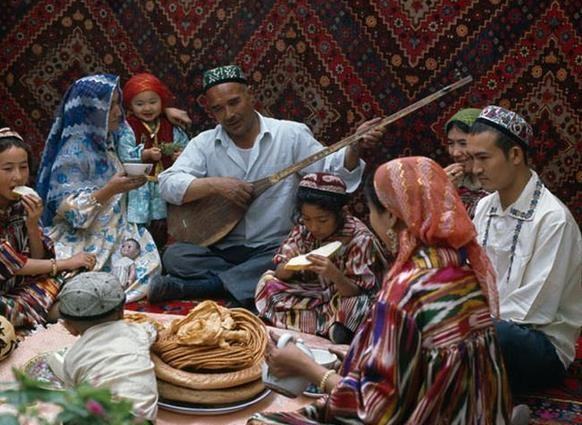Kumuz playing and singing
4 min readThis seemingly simple instrument of the Khaklhas is actually not that simple. And it has connection with Wang Zhaojun, one of the four beauties in Chinese history. It is said that after Wang Zhaojun went to the border to marry Huhanye Chanyu during the Western Han Dynasty(206 BC to 25 AD), she often played pipa to alleviate sorrow. But one day her pipa was broken, she had nothing to play with. So Huhanye Chanyu ordered an artisan to make her new one. But what the artisan made was not a pipa. Zhaojun called it hunbusi, which in today’s words means it was totally different. On the vast prairie, hunbusi became the mouth of this nomadic ethnic group who sang their history and feelings.
Manasqi singing

According to the Customs and Habits of the Kirgiz Ethnic Group, series of books on the survey materials of the society and history of China’s ethnic groups compiled by the State Ethnic Affairs Commission of the People’s Republic of China, kumuz was spread to Hun before the Han Dynasty. In Zhaohe Village of ancient Gaochang region in the west of Turpan, an ancient picture of the gth century was discovered. In the picture was a child who was playing huobusi (the predecessor of kumuz). During the Tang Dynasty, the ancestors of the Khaklhas presented this kind of instrument to the Tang Dynasty as a tribute, which was then presented to Japan as an instrumen of the Tang Dynasty. Two kinds of kumuz were among the tributes the Khaklhas paid to the Qing Court after Emperor Qianlong put down the rebel in southern Mt. Tianshan. One was a three-stringed kumuz and the other was a four-stringed kumuz (see the Authorized Drawings of Statutes of the Qing Dynasty). In the 13century when Genghis Khan undertook west expedition, he brought this kind of instrument to Badak Mountain, Kashmir, Central Asia, Persia, Arabia and other places. This is a great contribution of the Khaklhas to the musical treasure house of China and the world.
Resier Kaideqin stuck the plane thin plank to the due under part of the mould and started to burnish it. This was the third step and the procedure was almost finished.

The Khaklhas is one of the oldest ethnic groups of China, mostly inhabited in the Pamirs in Xinjiang which enjoys boundless grassland plenty of water and lush grass and flocks of sheep and herds of cattle. The Khalkhas, who love singing and dancing, would hold aken ballad singing while playing at festivals or parties, which would often last over night. It happened a lot that people got drunk while singing at the accompaniment of kumuz in this beautiful season. Aken ballad singing while playing is a pageant for the Khaklhas. People in all age brackets would be gathered wearing national costumes or casual clothes. Nothing else was better than singing Manas in pepping people up. The performance of kumuz was a real eye-opener. The musicians treated kumuz as if it were a horse. Kumuz was no longer an instrument in their hands. They put it on their laps then on their shoulder, or suddenly put it behind their head. Listeners were all dazed. The sound of kumuz was sometimes quick as the clatter of a horse’s hoofs or the storm roaring and sometimes was slow like breeze blowing. The entire band was like a horse caravan with uniform step which emitted uniform voice reverberating on the Akqi grassland. A small kumuz could be so powerful with such a power of expression. I couldn’t have believed it if I wasn’t there when it was played. The Khaklhas call those who are good at playing kumuz kumuzqi, which is an honorable title.
Resier Kaideqin began to install strings on kumuz, which meant a new kumuz was about to be created and a new kumuz player and singer were about to be born. I knew that the kumuz was finished when I saw Resier Kaideqin give a sigh of relaxation and take up the kumuz. He gave the kumuz to Ibrahim who was so happy as if he was carrying a baby. He turned to me, “It seems easy to make a kumuz, but in fact it is a process that needs professional handicraft, from the selection of material to the thickness of the plank to the tuning of the strings. Sometimes details of the handicraft are not teachable, but are only done with experience.” took up the kumuz from his hand and plucked clumsily, of course tuneless, but I was already immersed in the song which was being accompanied by kumuz.








